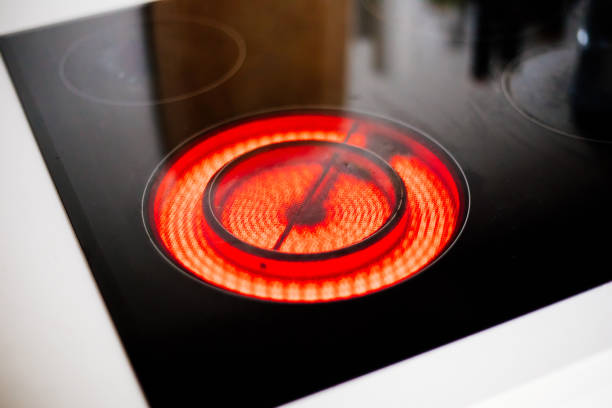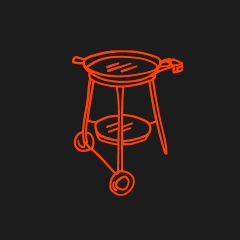How to prevent your paella from bulging
If there's one thing every buyer wants, it's for the products they purchase to last as long as possible. The paella pan, in practice, has an indefinite lifespan, but we've seen cases from customers and colleagues who tell us that their paella pan has warped or bent during use.
Believe it or not, preventing this issue is easier than it seems. However, to do so, you need to understand how and why it happens in order to avoid a warped paella pan.
What causes a paella pan to warp?
100% of the material used to make a paella pan is steel. Steel is malleable in two ways: First, the iron can be shaped using presses—this is how a paella pan is made. A steel coil is unrolled and passed through a press that gives it the characteristic truncated cone shape of a paella pan.
The second way is through excessive heat. Iron melts at around 1400°C (2552°F), but even at much lower temperatures, its original structure can be compromised.
Therefore, the main reason a paella pan bends is due to excessive heat. Over the years, paella manufacturers have aimed to create more efficient and affordable products that still work well, but they fall short of the quality and weight of paella pans made 20 years ago. This makes it essential to understand proper paella cooking techniques to avoid ending up with a bent pan.
The most vulnerable moments when a paella pan might warp are when the iron reaches its highest temperatures—these usually occur during the initial cooking stages:

- Leveling the paella pan: It's well known that properly leveling the pan before starting is crucial. This becomes especially important when you're making a paella with a very thin layer of rice, as unevenness is more visible and might even expose the metal.
Leveling must be done with the burner off. Otherwise, the pan’s metal will reach very high temperatures since, at that stage (before adding ingredients), only the metal retains the heat. This is the most delicate moment where unwanted warping can occur.
.jpg)
- The sofrito (sauté base): This step is essential. Oil acts as a vehicle for fat-soluble flavors, mainly from the meats. To extract the most flavor, the meat should be cooked on medium or low heat. This allows the fats to melt into the oil. Once the sofrito is done, water is added. As everyone knows, oil floats on water, and as the water evaporates and is absorbed by the rice, the oil layer descends, coating the rice grains and giving them the characteristic rich flavor of a good paella.
It's also important to use only the inner burner ring during this stage. This allows you to push the browned ingredients to the edges. Turning on all the burners creates excessive heat, increasing the risk of bending the pan.
From all of this, we learn that a proper sofrito must be done "poc a poc i amb bona lletra" (slowly and carefully), and this philosophy underpins modern paella pan design. What happens if you use high heat during the sofrito? Since there's no water at that stage, the metal heats up excessively and will eventually warp.
Interestingly, sometimes when water is added during cooking, the metal "relaxes" and returns to its original shape. This happens due to the sharp drop in temperature when the water (at room temperature) is added. However, this is a false fix—once the paella has lost the tension from its original shape, the next time you do a sofrito, it will likely bend again.
It’s important to know that during the stages of cooking where water or broth is present, the steel won’t suffer. That’s because water boils at a relatively low temperature (100°C / 212°F), and even if you increase the flame, it only speeds up evaporation but doesn’t increase temperature. So, using high heat during these stages doesn’t risk damaging the paella pan. Images like the one below may look dramatic, but they don’t actually pose a threat to the pan’s integrity.
.jpg)
Wood fire: intense flavor, higher risk
Traditionally, paella was cooked over a wood fire, which gives it a distinct flavor highly valued by gourmet paella lovers. However, wood fires are harder to control than gas and can be significantly hotter, making it easier to reach the temperatures that warp steel.
The same precautions apply as with gas burners, but in this case, it’s especially important to consider purchasing a thicker or professional-grade paella pan (also known as "pata negra"). These pans are built for heavy and professional use and are made from thicker steel, making them more resistant and ideal for high-intensity heat like wood fires or restaurant use.

Induction and ceramic stovetops: require the right type of pan
Induction and ceramic stovetops are harsher on the steel of your paella pan. That's why it's essential to use a pan specifically designed for these cooktops. These have a thicker base than traditional pans and are completely flat to ensure full surface contact.
Still, these pans aren’t immune to warping. The usual culprit remains excessive heat.
Key steps to prevent your paella pan from warping
From all the above, we can summarize a few basic and easy tips to help your paella pans last a lifetime—and even be passed on to the next generation:
1 – Level the pan with the burner off
2 – Do the sofrito on medium or low heat
3 – Use only the inner burner during the sofrito
4 – Reserve high heat for water or broth stages
5 – Choose a thick or professional pan if using high heat
Does this method work with any type of paella pan?
These recommendations apply to all types of paella pans, as they’re all made from steel—whether it's a polished pan, enameled pan, stainless steel pan, induction-compatible pan, or even a multifunctional pan.
Extra tips: gas regulator and windscreen
If you’re looking for a couple of extra tips, we recommend the following:
– The approved gas regulator (also known as a pressure regulator) for butane gas operates at 28/30 mbar. We know many customers use more powerful regulators, especially for large paellas where extra power is welcome. However, it’s worth noting that this is non-compliant, voids warranties, and compromises the safety features the burners were designed for. Using these increases burner power and therefore the risk of overheating, so extra care must be taken.
– While too much heat is dangerous, not providing enough heat is also problematic. If you're cooking paella outdoors, consider bringing a universal windscreen to prevent wind from reducing or extinguishing your flame. It also helps you save gas, as a properly installed windscreen creates an “oven effect” that improves heat efficiency and lowers gas consumption.






